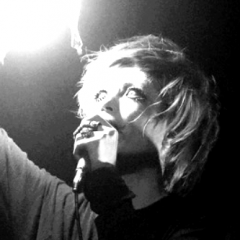As somebody who works in the field of movie & TV production (also worked on music-video shoots, but not on that many) all I can say is; there are various reasons... Hope you don't mind reading a longer text now... Most simple answer tho; music videos - if not on the high class sector - have limited budgets which means most of the time you only have one A-Cam (the main camera, biggest/best quality camera) and no B-Cam (ok, you can throw some GoPros in for action shots e.g. for guitar or drums, but for me that doesn't count as real B-Cam). Which means to achieve different shots and framings for cutting you have to change positions, you have to change the glass (if on primes), you often also have to change the lighting-setup or stage-setup in general. To do so you usually let the band play the full length of the song at least 2-3 times with breaks between the full song-runs to change the camera setup - which needs some time, after that you do so called pick-ups from various short parts which might be needed in addition (e.g. guitar or drum solo only, or maybe close-up of the eyes of the singer and so on - you get the idea). Now we get closer to the fact why playback is used and needed -> PV = promotional video -> means a video to promote and "sell" the band (after all it's a business) - which means you need to show off the best style, the best music quality, maybe the message or the art... That's why like 99% of music videos, especially PV's use the studio track of a song (final mix of a studio-recording) and not a "live-recording" and since it's nearly impossible to nail that a second, third, fourth time just for the video-recording (you need about the same timing, position- and sync-wise to have all the options when cutting) you usually do it with playback - thus it's also easier for the band members to focus more on the expressions, the "style", all the things you basically see in videos but usually not live on stage (e.g. stuff that would just be in the way at a live-setup/stage). It's also to get to the full length, to nail the right playing speed and so on - most musicians are used to performing lip-sync and I guess especially visual artists who care about appearance know how the stuff they do is looking or appearing to others (it's part of the game, you can even call it a 'show' sometimes - not in a bad way tho -> music often is 'entertainment' after all). Now about the cables where there are more options now; sometimes it's just a visual reason - cables don't look pretty pretty ( ) when you don't need it for compositing an image (sometimes you have them as visual part, without another function - e.g. to state chaos, to hang from walls, to 'strangle' ppl as part of the performance and so on) so for "clean" pictures you want to avoid them. Most of the time the cables are just not practical to perform the way the bands perform in PV's - which is - most of the time - over the top compared with a live performance. They have to move more, they usually are on heavier make-up or special costumes, the focus is more on the 'how do I (or stuff I do) look in camera' then on the 'how well do I play my instrument on a technical level' part (one more reason to use playback - you still have to make it look like it's well played but you don't need that exact same focus as on a 'real' performance). When shooting video (in general) it's also about the safety of all the ppl involved - you have big (hot) lamps standing around, you have (somewhat) expensive equipment that can be damaged during action, you have ppl running around doing stuff who shall not trip over cables and so on... Sometimes it's just a case of "no time to do the cabling" because of reasons like limited shooting time (you have to pay for locations, often by hour, you have to pay for personell and so on) or limited resources/budget (who brings or manages the cables - most of the time PV's are not shot at a concert location or recording studio but more like at a TV/Greenscreen-Studio or "on location" where you have to bring and carry all the stuff you need there yourself). Sometimes the stuff used is only a "Prop" without function and not the "real" thing - because real instruments are expensive and you don't want to damage them (again). So even if this stuff has 'real' plugs it might not be able to be turned on so it makes no sense to do so. As mentioned when you use water or rain for visual reasons or e.g. play at really cold or really hot locations you don't want to use electricity because of safety reasons or if not to protect ppl just to protect your equipment. Sometimes you also don't want to have lights and LED-lights of eg. the turned on AMP in you picture because it might cause flares and it might cause reflections and so on. Ever noticed that about all of the professional gear is black or even has a matte finishing -> that's because of reflections (which are a nasty thing, and sometimes mean a lot of work to avoid them - because you don't want to see the whole crew in a mirrored reflection at any time - lot's of fun when you shoot at small/tight places with mirroring stuff in there). After all these PV's should look 'good', and sometimes good doesn't automatically mean 'realistic', film involves lot of tricking the audience or faking stuff but in the end result you might not even notice it... Or only if you focus on it or take a closer look, or have the knowledge to see it... Edit: one thing I forgot -> often it's also because of the power output/source limitations; on location is often not possible to provide enough output to power all the stuff as most of the power will be needed for lighting the scene (we talk about lamps up to like 2.5 Kilowatt to achieve daylight, even the smaller ones are like 650 to 800 Watt each - if you don't run everything on LED-Stuff which still is more expensive then 'regular' light... And on music video's you are usually on a tighter budget which means you don't have the money for the most expensive, power-saving stuff). So if you need all the power plugs for the film-department (which usually also spans to much more departments then 'camera' only, who will also need power-plugs and power in general) you might not be able to also power the whole 'music'-department (Amps and stuff) without killing the power line.
Edit 2: About the "let's post videos (PV's?) where the band plays actually" -> those are performance videos or live-recordings / studio-recordings then and a totally 'different type' of video or attempt actually... As told earlier; a PV is used to sell al single or an EP or an album - so you want to show ppl how the stuff on the album actually sounds, with the actual, finished audio track from the CD. Which also means you want to show them it's a 'good' product with 'good' production and 'good' sound (despite you want to sell is as hard/dirty/grunge sound or with genres that actually have to sound 'bad'). For the CD-versions they achieve(d) this sound at a (maybe home-)Studio, with lots of work and time, with good mixing, with post-production, with separate recorded instruments and vocals and so on (sure, you can also record 'as a band' but even then it's not the same situation in a studio as it is 'live'). There's usually _no way_ to sound like that on a location where you shoot a PV - except you shot while actually recording; which makes the whole thing a studio-recording video (sometimes you get those as 'making of on DVD's or limited editions). So for me a PV is already 'playback' per definition most of the time - if not then it's just not a 'regular' PV... Hope you can follow me here.
Edit 3: simple communication - the director often needs to communicate with the cameraman during the shot if he notices e.g. wrong framing or if he wants something different then the cameraman at a moment, usually on at least one of the full-length runs you have hand-camera action with freestyle framing and the camera just moving around on the scene to get (usually dynamic) additional shots. Depends on the production tho - some PV's are only from fixed positions (tripod) or from a circle-track with a dolly and so on - but usually it also involves a dynamic camera, can also be a steadycam or gimbal... For that it's much easier for the camera personell to work in a silent surrounding - you don't want to run around between the playing band members (which is difficult enough) and then in addition be blasted on with loud stuff from the Amps (which also cause vibrations btw, also a thing you don't want to have on video). Video involves focus, involves smooth moves, steady and recall-able movements or shots and so on -> all of that is much easier to achieve when you're not blasted away with loud music. The playback is usually just loud enough for the musicians to follow the timing or to get the starting point (then turned off for the freestyle part) - sometimes it's even through in-ear monitoring only, at least it's never on concert-volume. Just to mention; one of the number-one rules on set is; don't be loud, don't make any noise, don't even move, turn off your phone... at least that's how professionals do it, if you don't obey that rule you won't work in that field for long. Hmm, I think I got most of it covered - for more specific reasons; just ask





 Big thanks for writing me on last.fm btw - that made me smile <3 (and sorry for not responding tho)
Big thanks for writing me on last.fm btw - that made me smile <3 (and sorry for not responding tho)





